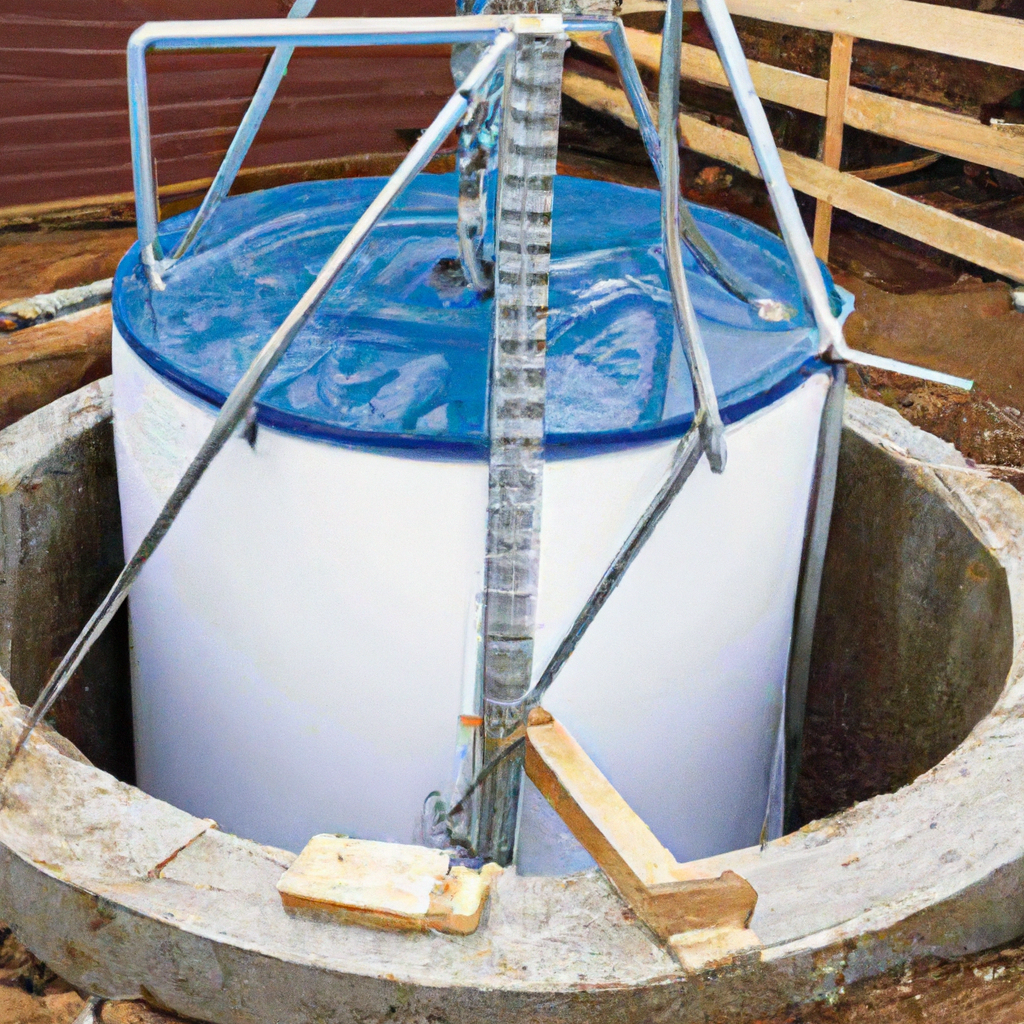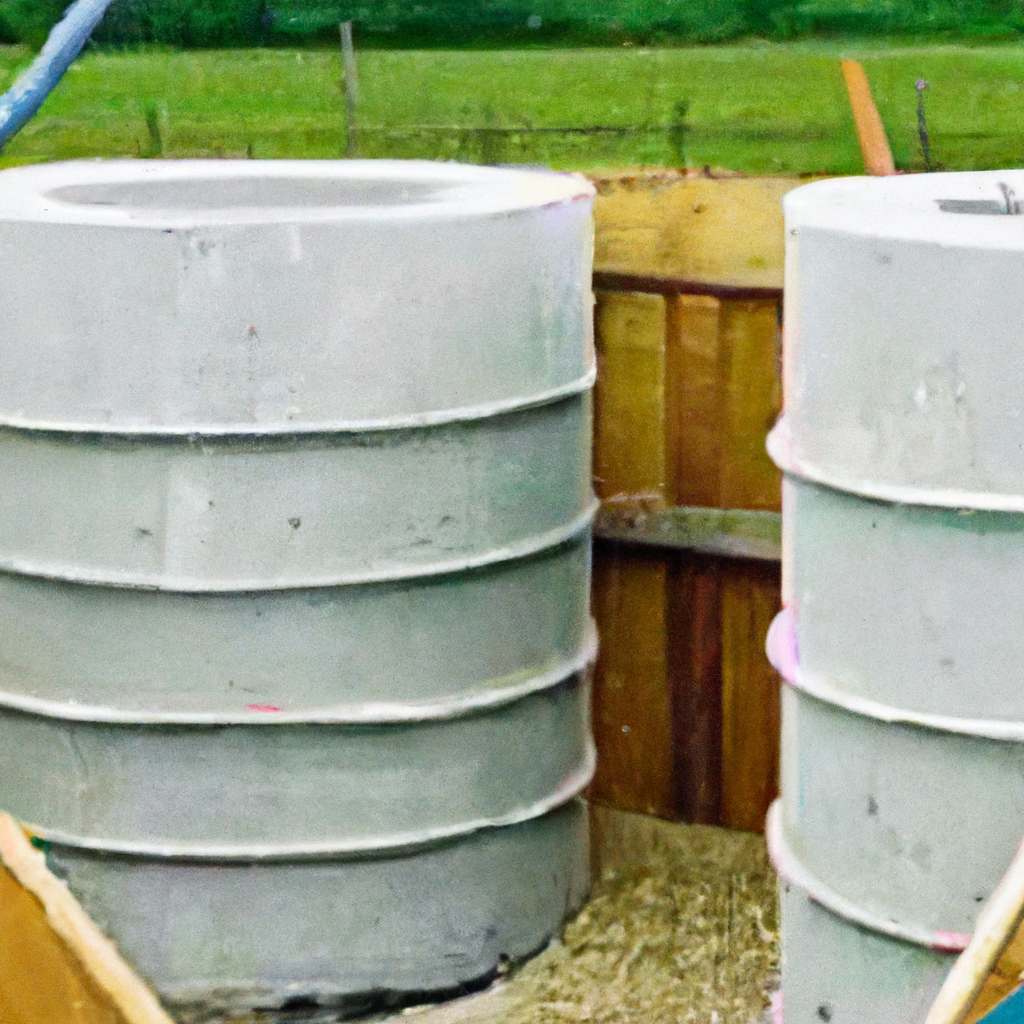Are you tired of struggling to access your septic tank lid and dealing with the mess that comes with it? Look no further! This article will provide you with a simple and straightforward guide on how to install concrete septic tank lid risers. These risers are designed to make your life easier by raising the lid of your septic tank closer to the surface, eliminating the need for tedious digging and reducing the likelihood of costly repairs. Whether you’re a DIY enthusiast or simply looking for an efficient solution, this article has got you covered. So let’s get started and learn how to install concrete septic tank lid risers in just a few easy steps.

Understanding Septic Tank Risers
Definition of Septic Tank Risers
Septic tank risers are vertical extensions that are installed on top of septic tanks, providing easy access and maintenance to the tank. These risers are usually made from durable materials such as concrete or plastic. They act as an extension of the septic tank lid, allowing it to be brought closer to the surface, making it easier to locate and access the tank for regular inspections, cleaning, and pumping.
Necessity of Septic Tank Risers
Septic tank risers are an essential component of any septic system for several reasons. First and foremost, they eliminate the need for digging and excavating the ground every time maintenance work needs to be done on the septic tank. This saves time, effort, and money in the long run. Additionally, the risers provide a safe and secure access point to the septic tank, reducing the risk of accidents or injuries during maintenance activities. They also prevent debris and soil from falling into the tank, improving its overall functionality and lifespan.
Types of Septic Tank Risers
There are various types of septic tank risers available in the market, each with its own set of advantages and disadvantages. The two most common types are concrete risers and plastic risers. Concrete risers are durable, strong, and resistant to damage from external forces. They can withstand heavy loads and are less likely to crack or break over time. Plastic risers, on the other hand, are lightweight and easy to install. They are more affordable than concrete risers and are resistant to corrosion and rust. The choice between concrete and plastic risers depends on individual preferences, budget, and specific needs.
Basics of Concrete Septic Tank Lid Risers
Characteristics of Concrete Risers
Concrete risers are made from high-quality concrete that is reinforced with steel for added strength and durability. They are designed to withstand heavy loads and harsh environmental conditions. Concrete risers are resistant to damage from weather elements, chemicals, and pressure, making them a reliable choice for septic tank installations. They are also available in various sizes to accommodate different tank dimensions.
Pros and Cons of Concrete Risers
One of the main advantages of concrete risers is their exceptional durability. They can withstand the weight of vehicles and heavy equipment without cracking or collapsing. Concrete risers also provide a stable and secure access point, ensuring the safety of individuals working around the septic tank. Additionally, concrete risers have a long lifespan and require minimal maintenance.
However, concrete risers can be more expensive compared to other alternatives such as plastic risers. They can also be heavier and more challenging to install without the proper equipment or expertise. Furthermore, concrete risers may be susceptible to slight shifts or settling of the ground, which can cause misalignment and potential issues with the septic tank lid.
Required Material for Installation
List of Necessary Tools
To install a concrete septic tank lid riser, you will need the following tools:
- Shovel or excavation equipment for digging
- Level and measuring tape for proper alignment
- Rubber mallet or hammer for securing the riser in place
- Masonry or concrete saw for cutting through the existing septic tank lid
- Safety goggles and gloves for protection
- Screwdriver or wrench for attaching the riser to the septic tank
Safety Equipment Needed
When working with concrete and performing installation tasks, it is crucial to prioritize safety. Be sure to have the following safety equipment:
- Safety goggles or glasses to protect your eyes from debris
- Work gloves to protect your hands
- Sturdy footwear with non-slip soles for firm footing
- Dust mask to prevent inhalation of dust particles
- Reflective vest or clothing for increased visibility, especially if working near traffic
Choosing the Right Size of Riser
Before starting the installation process, it is necessary to determine the appropriate size of the septic tank lid riser. Measure the dimensions of the existing septic tank lid and choose a riser that matches those measurements. Selecting the correct size ensures a snug fit and prevents any gaps or misalignments that may lead to potential issues in the future.
Preparation for Installation
Safety Precautions
Prioritize safety during the preparation and installation stages. Ensure the work area is clear of any potential hazards, such as loose soil, rocks, or debris. If working near electrical lines or other utilities, take the necessary precautions to avoid accidents. Additionally, notify any relevant parties, such as utility providers or neighbors, about the upcoming installation work for further safety measures.
Inspection of the Septic Tank
Before installing the septic tank lid riser, conduct a thorough inspection of the septic tank. Look for any signs of damage, leaks, or blockages. Ensure that the septic tank is in proper working condition, as installing a riser on a compromised tank may exacerbate existing issues. If any concerns or problems are identified, it is recommended to consult a professional for further assessment and necessary repairs.
Marking the Installation Area
Using spray paint or another marking tool, outline the area where the septic tank lid riser will be installed. This will serve as a guide during excavation, ensuring that the hole is dug in the correct location and to the proper depth. Take measurements and use a level tool to ensure accurate placement.

Removing the Old Septic Tank Lid
Considerations For Removing Old Lid
Removing the old septic tank lid requires caution and attention to detail. Before proceeding, make sure to:
- Shut off the septic tank’s inlet and outlet valves to prevent any sewage backup or spills during lid removal.
- Clear the area around the lid, removing any dirt or debris that may obstruct the process.
- Be aware of the weight of the lid and the force required to lift it, as it can be heavy and cumbersome.
Proper Way To Lift The Old Lid
To lift the old septic tank lid safely, follow these steps:
- Position yourself correctly, ensuring that you have a firm and well-balanced footing.
- Use proper lifting techniques, bending at the knees and keeping your back straight.
- Lift the lid slowly and steadily, using your legs and core strength rather than relying solely on your arms.
- Have a partner assist you if the lid is particularly heavy or if additional support is needed.
Disposing of the Old Lid
Properly disposing of the old septic tank lid is crucial to ensure the safety of others and the environment. Check with local regulations and disposal guidelines. In most cases, the lid can be taken to a designated recycling or waste management facility. Avoid simply discarding the lid in regular trash bins or burying it, as it may pose a hazard and contaminate the surrounding soil and water sources.
Installing the Concrete Septic Tank Lid Riser
Steps in Installing the Riser
Follow these steps to install the concrete septic tank lid riser:
- Prepare the excavation area by carefully removing soil to the necessary depth and diameter to accommodate the riser.
- Place the concrete riser onto the septic tank, ensuring a snug and secure fit.
- Use a rubber mallet or hammer to tap the riser into place, ensuring it is level and aligned with the surrounding ground.
- If necessary, add additional riser sections to reach the desired height, ensuring each section is properly aligned and securely fastened.
- Once the riser is in place, fill in the gaps surrounding the riser with soil, compacting it gently to stabilize the area.
Ensuring a Perfect Fit
To ensure a perfect fit for the septic tank lid riser:
- Measure the dimensions of the septic tank and the riser carefully.
- Double-check the alignment and positioning of the riser to ensure it matches the septic tank’s location.
- Use a level tool to verify that the riser is straight and properly aligned.
Setting the Concrete Lid in Place
Once the riser is securely installed, place the concrete septic tank lid on top of the riser. Ensure that it fits snugly and seals the riser effectively. The weight of the lid will help create a tight seal, preventing air or water from entering the septic tank. Ensure that the lid is properly aligned and level to facilitate easy access and maintenance.

Sealing the Riser Lid
Types of Seals for Riser Lids
There are several options for sealing the riser lid, including butyl rubber gaskets, adhesive sealants, and expanding foam sealants. Butyl rubber gaskets are commonly used for their durability and resistance to water and air ingress. Adhesive sealants provide a strong bond between the lid and the riser, ensuring a secure and watertight seal. Expanding foam sealants fill any gaps or irregularities around the lid, preventing the intrusion of pests or foul odors.
Proper Method of Sealing
To seal the riser lid effectively, follow these steps:
- Clean the contact surfaces of the lid and the riser to ensure a clean and smooth bonding surface.
- Apply the selected sealant or gasket to the lid or the riser according to the manufacturer’s instructions.
- Slowly and carefully position the lid onto the riser, pressing it firmly and evenly to create a tight seal.
- Wipe away any excess sealant or foam to achieve a clean and professional finish.
Checking for Proper Seal
After sealing the riser lid, it is essential to check for a proper seal. Inspect the area around the lid for any leaks, visible gaps, or signs of moisture ingress. Run water over the lid and observe if there are any water leaks or drainage issues. If any issues are detected, reevaluate the sealant or gasket used and ensure proper alignment and installation.
Post Installation Checks
Inspecting for Leaks
Once the septic tank lid riser is installed, it is crucial to conduct regular inspections for leaks or any signs of potential issues. Check the seal between the lid and the riser, as well as the connection points between the riser sections. Look for any visible gaps, cracks, or water stains, as these may indicate a faulty seal. Promptly addressing any leaks or issues will help maintain the functionality and efficiency of the septic system.
Verifying Riser Stability
Ensure the stability of the septic tank lid riser by periodically checking for any movement or shifting. Pay attention to any signs of settling or ground movement around the riser. If any instability is detected, it may be necessary to reinforce the surrounding area or consult a professional for further assessment.
Maintenance Tips for Concrete Septic Tank Lid Risers
To keep your concrete septic tank lid risers in optimal condition:
- Regularly inspect the riser lid, checking for any signs of wear, cracks, or damage.
- Keep the area around the riser clear of debris, soil, or vegetation that may impede access or cause damage.
- Perform routine maintenance tasks such as cleaning the lid and inspecting the sealant to ensure it remains intact and effective.
- Schedule regular septic tank inspections and maintenance to address any potential issues before they become severe or costly.

Troubleshooting Common Issues
Overcoming Installation Challenges
During the installation process, some challenges may arise. Here are some common issues and solutions:
- Poor alignment: Double-check measurement and alignment before securing the riser in place. If misalignment occurs, carefully remove and reposition the riser.
- Difficulty in removing the old lid: Utilize proper lifting techniques and, if needed, seek assistance from others to safely remove the old lid.
- Ground settling: Provide additional support, such as compacted gravel or sand, to prevent ground settling and maintain riser stability.
- Leaks or gaps: Reevaluate the sealant or gasket used and verify proper installation and alignment. Apply additional sealant or foam to address any leaks or gaps.
Resolving Common Post-Installation Problems
If issues arise after the installation of a concrete septic tank lid riser, consider the following solutions:
- Leaks around the riser lid: Check the sealant or gasket for any damage or deterioration, and replace as necessary. Ensure proper alignment and installation to create an effective seal.
- Unstable or shifting riser: Reinforce the area surrounding the riser with additional soil, gravel, or compacted materials to increase stability. Consult a professional if stability issues persist.
- Lid difficulty or obstruction: Clean the lid and riser of any debris or buildup. Lubricate hinges or moving parts as needed to facilitate easy opening and closing of the lid.
Professional Installation vs DIY
Benefits of Hiring a Professional
While installing a concrete septic tank lid riser can be done as a DIY project, there are several benefits to hiring a professional:
- Expertise and experience: Professionals have extensive knowledge and experience in septic system installations, ensuring proper installation and minimizing potential issues.
- Cost and time savings: Professionals have the necessary tools and equipment to complete the installation efficiently. They can also advise on the appropriate size and type of riser, preventing costly mistakes.
- Compliance with regulations: Professionals are well-versed in local regulations and guidelines, ensuring that the installation meets all necessary requirements.
Cost Considerations
The cost of installing a concrete septic tank lid riser can vary depending on various factors such as the size of the tank, the depth of installation, and the labor involved. DIY installation may be more cost-effective initially, as it eliminates labor costs, but it may not guarantee the same level of expertise or long-term durability. It is essential to weigh the upfront cost savings against the potential risks and ongoing maintenance expenses associated with DIY installation.
When DIY is Feasible
DIY installation of a concrete septic tank lid riser may be feasible under the following circumstances:
- Adequate knowledge and understanding of septic system components and their installation procedures.
- Access to necessary tools, equipment, and safety gear.
- Confidence in accurately measuring and aligning the riser.
- Willingness to conduct thorough research and follow instructions meticulously.
Before embarking on a DIY installation, carefully assess your capabilities, consider the potential risks, and consult professionals or local authorities for guidance if needed.
In conclusion, understanding the importance of septic tank risers and the installation process is crucial for maintaining a functional and efficient septic system. By following the steps outlined in this guide and considering the various factors involved, you can ensure a successful installation of a concrete septic tank lid riser. Remember to prioritize safety, regular inspections, and proper maintenance to prolong the lifespan of your septic system and prevent costly repairs in the future.

